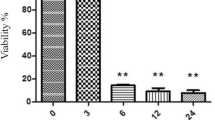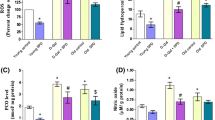Abstract
Humanin (HN) has been reported to be an endogenous peptide that exerts highly selective neuroprotection against cell death induced by various types of Alzheimer's disease-related insults. We previously proposed the much broader cytoprotective potential of HN from the result that HN suppressed serum-deprivation-induced death of rat pheochromocytoma cells. In this study, we showed that HN also suppressed death of human lymphocytes cultured under serum-deprived condition. Further, we revealed, by assaying metabolic activity and survival rate, that HN was a potent factor capable of increasing the metabolic activity of individual serum-deprived lymphocytes. To our knowledge, there is no report described about a rescue factor that increases the metabolic activity of individual serum-deprived cells and prolongs their survival. This novel feature of HN may enable us to apply this peptide for the management of diseases involving poor metabolic activity, such as mitochondria-related disorders and brain ischemia.
Similar content being viewed by others
References
Selkoe DJ: Physiological production of the beta-amyloid protein and the mechanism of Alzheimer's disease. Review. Trends Neurosci 16: 403-409, 1993
Ashall F, Goate AM: Role of the beta-amyloid precursor protein in Alzheimer's disease. Review. Trends Biochem Sci 19: 42-46, 1994
Checler F: Processing of the beta-amyloid precursor protein and its regulation in Alzheimer's disease. Review. J Neurochem 65: 1431-1444, 1995
Goate A, Chartier-Harlin MC, Mullan M, Brown J, Crawford F, Fidani L, Giuffra L, Haynes A, Irving N, James L: Segregation of a missense mutation in the amyloid precursor protein gene with familial Alzheimer's disease. Nature 21: 704-706, 1991
Sherrington R, Rogaev EI, Liang Y, Rogaeva EA, Levesque G, Ikeda M, Chi H, Lin C, Li G, Holman K: Cloning of a gene bearing missense mutations in early-onset familial Alzheimer's disease. Nature 375: 754-760, 1995
Levy-Lahad E, Wijsman EM, Nemens E, Anderson L, Goddard KA, Weber JL, Bird TD, Schellenberg GD: A familial Alzheimer's disease locus on chromosome 1. Science 269: 970-973, 1995
Cummings JL, Vinters HV, Cole GM, Khachaturian ZS: Alzheimer's disease: Etiologies, pathophysiology, cognitive reserve, and treatment opportunities. Review. Neurology 51: S2-S17; discussion S65–S67, 1998
Fassbender K, Masters C, Beyreuther K: Alzheimer's disease: Molecular concepts and therapeutic targets. Review. Naturwissenschaften 88: 261-267, 2001
Hashimoto Y, Niikura T, Tajima H, Yasukawa T, Sudo H, Ito Y, Kita Y, Kawasumi M, Kouyama K, Doyu M, Sobue G, Koide T, Tsuji S, Lang J, Kurokawa K, Nishimoto I: A novel rescue factor abolishing neuronal cell death by a wide spectrum of familial Alzheimer's disease genes and Aβ. Proc Natl Acad Sci USA 98: 6336-6341, 2001
Hashimoto Y, Niikura T, Ito Y, Sudo H, Hata M, Arakawa E, Abe Y, Kita Y, Nishimoto I: Detailed characterization of neuroprotection by a rescue factor Humanin against various Alzheimer's disease-relevant insults. J Neurosci 21: 9235-9245, 2001
Hashimoto Y, Ito Y, Niikura T, Shao Z, Hata M, Oyama F, Nishimoto I: Mechanisms of neuroprotection by a novel rescue factor Humanin from Swedish mutant amyloid precursor protein. Biochem Biophys Res Commun 283: 460-468, 2001
Kariya S, Takahashi N, Ooba N, Kawahara M, Nakayama H, Ueno S: Humanin inhibits cell death of serum-deprived PC12h cells. Neuroreport 13: 903-907, 2002
Alnemri ES: Hidden powers of the mitochondria. Nature Cell Biol 43: 465-475, 1999
Berridge MV, Tan AS: Characterization of the cellular reduction of 3-(4,5-dimethylthiazol-2-yl)-2,5-diphenyltetrazolium bromide (MTT): Subcellular localization, substrate dependence, and involvement of mitochondrial electron transport in MTT reduction. Arch Biochem Biophys 303: 474-482, 1993
McElroy WD, DeLuca MA: Firefly and bacterial luminescence: basic science and applications. J Appl Biochem 5: 197-209, 1983
Ebstein RP, Nemanov L, Lubarski G, Dano M, Trevis T, Korczyn AD: Changes in expression of lymphocyte amyloid precursor protein mRNA isoforms in normal aging and Alzheimer's disease. Mol Brain Res 35: 260-268, 1996
Batistatou A, Greene LA: Internucleosomal DNA cleavage and neuronal cell survival/death. J Cell Biol 122: 523-532, 1993
Zhang XJ, Yan J, Cuttle L, Endre Z, Gobe G: Escape from apoptosis after prolonged serum deprivation is associated with the regulation of the mitochondrial death pathway by Bcl-xL. Biochem Biophys Res Commun 277: 487-493, 2000
Atabay C, Cagnoli CM, Kharlamov E, Ikomovic MD, Manev H: Removal of serum from primary cultures of cerebellar granule neurons induces oxidative stress and DNA fragmentation: Protection with antioxidants and glutamate receptor antagonists. J Neurosci Res 43: 465-475, 1996
Barrientos A, Casademont J, Cardellach F, Estivill X, Urbano-Marquez A, Nunes V: Reduced steady-state levels of mitochondrial RNA and increased mitochondrial DNA amount in human brain with aging. Mol Brain Res 52: 284-289, 1997
Tokunaga M, Mita S, Sakuta R, Nonaka I, Araki S: Increased mitochondrial DNA in blood vessels and ragged-red fibers in mitochondrial myopathy, encephalopathy, lactic acidosis, and stroke-like episodes (MELAS). Ann Neurol 33: 275-280, 1993
Papa S, Skulachev VP: Reactive oxygen species, mitochondria, apoptosis and aging. Mol Cell Biochem 174: 305-319, 1997
Rusanen H, Majamaa K, Hassinen IE: Increased activities of antioxidant enzymes and decreased ATP concentration in cultured myoblasts with the 3243A → G mutation in mitochondrial DNA. Biochim Biophys Acta 1500: 10-16, 2000
Harris LK, Black RT, Golden KM, Reeves TM, Povlishock JT, Phillips LL: Traumatic brain injury-induced changes in gene expression and functional activity of mitochondrial cytochrome C oxidase. J Neurotrauma 18: 993-1009, 2001
Abel MS, McCandless DW: Elevated gamma-aminobutyric acid levels attenuate the metabolic response to bilateral ischemia. J Neurochem 58: 740-744, 1992
Author information
Authors and Affiliations
Rights and permissions
About this article
Cite this article
Kariya, S., Takahashi, N., Hirano, M. et al. Humanin improves impaired metabolic activity and prolongs survival of serum-deprived human lymphocytes. Mol Cell Biochem 254, 83–89 (2003). https://doi.org/10.1023/A:1027372519726
Issue Date:
DOI: https://doi.org/10.1023/A:1027372519726




